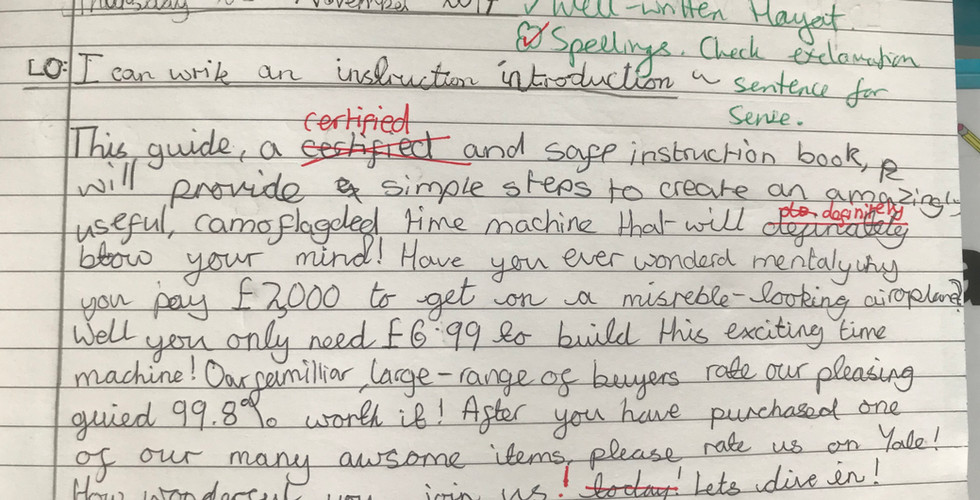Do Half as Much, Twice as Well
- Mr D

- Mar 27, 2018
- 3 min read
Updated: Nov 13, 2022
Slow Writing
The new curriculum has placed editing and re-drafting at the heart of writing and this is no bad thing. Those who rush a formal letter, forget to proof-read an email or hand in a first draft of an essay, needless to say, end up regretting doing so. In real life, we edit, improve and think carefully when writing all the time and so developing those skills early on promotes both a growth mind set and critical thinking when putting pen to paper.
Ever since David Didau's 2014 book 'The Secret of Literacy: Making the Implicit Explicit' discussed the idea of Slow Writing, this practice has made its way around primary schools across the UK as a way of limiting children to a structured set of criteria and forcing them to slow down, consider their work carefully and allow for plenty of assessment for learning to take place too. His blog post from 2012 is also worth reading here:
It relies on giving children specific sentences to write in a chosen order such as:
1.) Start with a subordinating conjunction
2.) Use two adjectives
3.) Use parenthesis to add more information
4.) Use commas in a list
5.) End with an exclamation mark
Much like The Literacy Shed has a very useful 'DADWAVERS' mnemonic, it's another strategy to help children consider their writing sentence-by-sentence rather than veering off on a tangent, losing all sense of grammar and punctuation along the way.
It is no silver bullet and it’s not independent either but, as long as children in class still have opportunities for 'free writing' and less prescriptive activities, it can be used to great effect and even played around with to keep children on their toes. Mixed with Alan Peat's Exciting Sentences, limited word counts, unusual vocabulary or even disallowed letters, it can be used in ways children didn't think possible.

The Overall Process
1.) In order to support the editing and redrafting element to Slow Writing, I ensure children are given an initial template consisting of white and grey lines. It's here children write on the white lines and edit above it on the grey lines. This is done at a snail's pace, a sentence at a time, each time up-levelling, reading aloud and checking before moving onto the next sentence.
2.) Once the first draft has been created, children work together with 'response partners' giving appropriate feedback and opportunities to correct spellings, use thesauruses and check punctuation and grammar. At this point, children read aloud to the class during intervals and discussions are had about it's 'flow' (e.g. are words or phrases repeated or sounding clunky? What works and what doesn't?)
3.) Children copy this in neat and the teacher takes it away to give further feedback. The children use this feedback to edit, up-level or improve once again. At this point, I have found children are incredibly proud of their work and enjoy seeing the draft version ironed out and presented well in their book.
4.) It's after this process that I have either stopped or children have created a 'final piece' such as typing it up as a formal letter, recording an audio version as an advert or simply celebrating and sharing work by reading it aloud to other classes or members of staff.
Do Half as Much, Twice as Well
The idea of slowing down and doing your very best seemed to take a while to be fully appreciated by children initially but now it is beginning to shape everything they do. Maths Mastery has slowed things down so that children think deeply and fully understand a concept rather than racing off and answering 100 questions and reading has become more about honing in on specific vocabulary and inferences than just rattling through reading comprehensions.
Austin's Butterfly is a lovely example of this being used in art or science observations. Check the video here:
I decided to complete this activity in a Year 3 class a few years back and so created a PowerPoint, re-drawing the butterfly pictures and teaching the children in class to slow down, re-draft their art and provide feedback that was kind, helpful and specific. Download it for free HERE.
Could this applied elsewhere in the curriculum? I’m not sure but drafting shouldn’t just be in English lessons. Science observations, ICT presentations, PSHE work or any other lesson could easily be utilised as an opportunity to edit, redraft and improve work. Let’s slow down and make everything twice as good.
Mr D
- To download the Slow Writing Pack CLICK HERE.

TES Rating = 5 stars









Comments